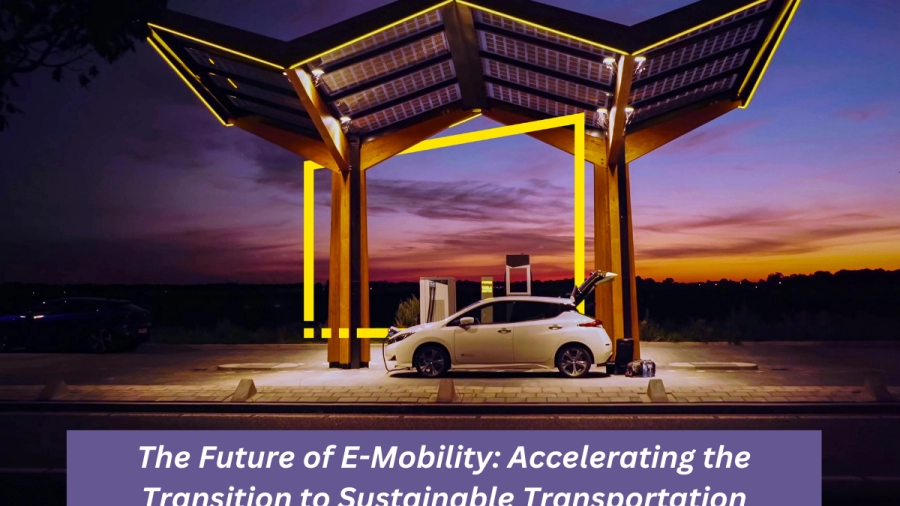The Future of E-Mobility: Accelerating the Transition to Sustainable Transportation: As the world grapples with the challenges of climate change and the need to reduce greenhouse gas emissions, the transition to sustainable transportation has become a global imperative.
Electric mobility is emerging as a key solution to decarbonize transportation and create a cleaner, greener future. In this article, I will explore the future of E-Mobility and how it is accelerating the transition to sustainable transportation. I will discuss the benefits of E-Mobility design solutions and highlight the key factors driving the widespread adoption of EVs.
Environmental Benefits of Electric Mobility Solutions
Electric mobility solutions offer significant environmental benefits, making them a crucial component of sustainable transportation. EVs produce zero tailpipe emissions, helping to reduce air pollution and improve air quality in urban areas.
By transitioning from fossil fuel-powered vehicles to EVs, overall carbon footprint of the transportation sector can be decreased. EVs are charged using renewable energy sources, such as solar or wind power, leading to a truly sustainable transportation ecosystem.
Technological Advancements and Improved Infrastructure
The future of eMobility relies on continuous technological advancements and improvements in charging infrastructure. Battery technology, the backbone of EVs, is rapidly evolving, leading to increased energy storage capacity, and shorter charging times. Development of fast-charging infrastructure are addressing the issue of range anxiety and making EV charging more convenient and accessible.
As the charging infrastructure becomes more widespread and efficient, the barriers to adopting EVs are gradually being eliminated.
Government Policies and Incentives
Government support and favorable policies play a crucial role in accelerating the transition to electric mobility. Many countries and regions are implementing ambitious targets and regulations to promote the adoption of EVs. Governments are offering financial incentives, tax benefits, and subsidies to make EVs more affordable and attractive to consumers.
Additionally, investments in charging infrastructure development and the establishment of charging standards further support the growth of eMobility. These policies create a favorable environment for the widespread adoption of electric mobility solutions.
Cost Reduction and Improved Affordability
The future of eMobility is also driven by the decreasing costs of EVs and their components. As the technology matures and economies of scale come into play, the prices of EVs are gradually becoming more competitive with their internal combustion engine counterparts.
Battery costs, in particular, have seen significant reductions, making EVs more affordable for a wider range of consumers. Expect the shift towards mobility-as-a-service models to transform the way people travel and contribute to more sustainable urban mobility.
Technological Convergence and Integration
In the future, E-Mobility will not be limited to EVs alone. It involves the convergence and integration of various technologies to create a comprehensive sustainable transportation ecosystem. This includes the integration of EVs with renewable energy sources, smart grids, energy storage systems, and intelligent transportation systems.
The synergy between these technologies enables efficient energy management, optimized charging, and seamless integration of EVs into the overall transportation infrastructure. The integration of electric mobility solutions with emerging technologies such as artificial intelligence and Internet of Things (IoT) further enhances the efficiency and capabilities of EVs.
Enhanced User Experience and Innovative Mobility Services
The future of eMobility goes beyond individual ownership of EVs. It encompasses innovative mobility services such as ride-sharing, carpooling, and on-demand electric vehicle fleets. These services provide convenient and flexible transportation options while reducing the overall number of vehicles on the road.
By leveraging digital platforms and mobile apps, users can easily access electric mobility solutions, plan their trips, and select the most suitable mode of transportation. The shift towards mobility-as-a-service models will transform the way people travel and contribute to more sustainable urban mobility.
Conclusion
The future of E-Mobility holds tremendous potential in accelerating the transition to sustainable transportation. Electric mobility solutions offer environmental benefits, technological advancements, and improved infrastructure that make EVs a viable and attractive option for consumers.
Government policies, cost reductions, and technological convergence further support the widespread adoption of EVs. As the electric mobility ecosystem continues to evolve, it will reshape the transportation landscape, enhance the user experience, and pave the way for a cleaner, greener future.

